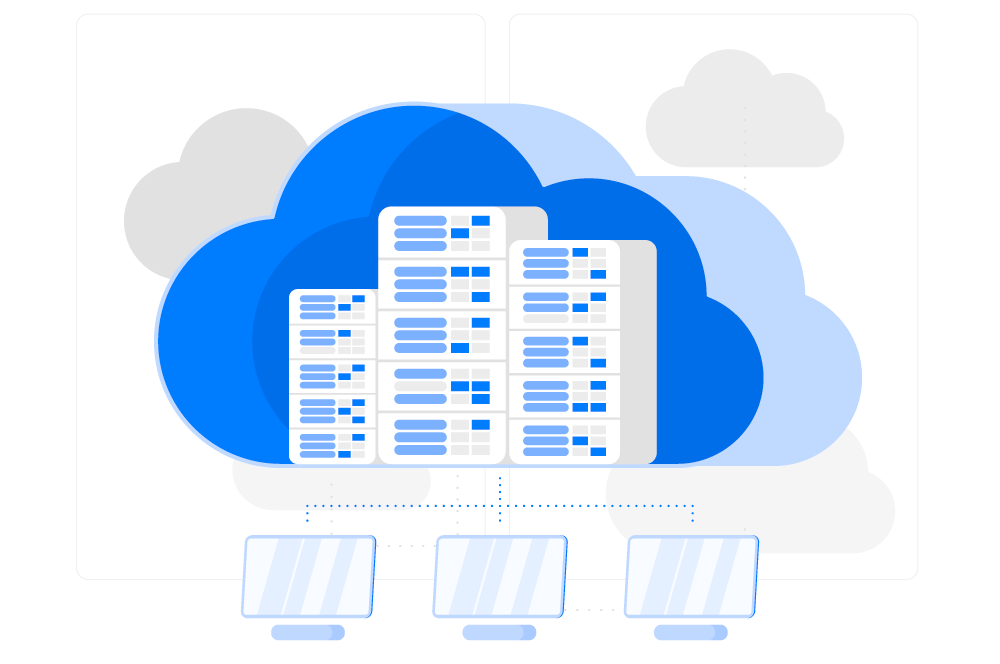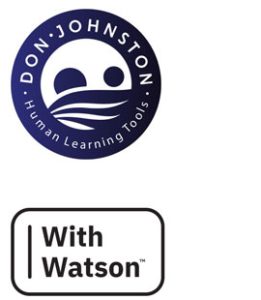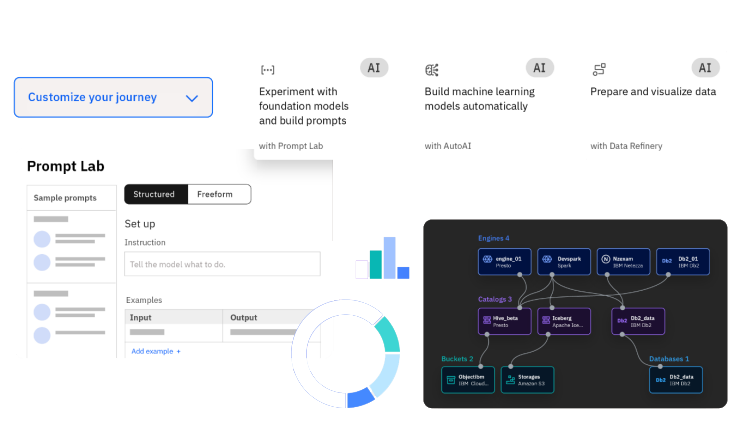Put Generative AI to work for your business
Enterprise-ready solutions supercharged by IBM!

Recent News
Recent Posts
Past Webinar
Ride the AI wave with IBM's cutting-edge solutions
Get Hands-on with watsonx - IBM's Next-Gen AI and Data Platform.
According to a report by McKinsey Global Institute, generative AI could create $2.6 trillion in economic value by 2030

The demand for generative AI skills has grown by 50% in the past year.
(source: linkedin)
(source: linkedin)
Put AI to work
CodeObjects
Creating a frictionless experience for insurance customers, even during disasters
-
Business Challenge
-
Transformation
-
Results
-
Business challenge story
-
Transformation story
-
Results story
-
CodeObjects
In the insurance industry, some of the most important calls come under some of the most stressful circumstances. That’s why CodeObjects is using IBM Watson® technology to develop InsurBot.ai, an AI assistant that eliminates call center holds, reduces costs and helps put anxious customers on the road to recovery quickly.
Business Challenge
Insurance calls surge after natural disasters, creating backlogs and long waits for policyholders. CodeObjects wanted to use AI technology to help insurance companies respond to calls more quickly.
Transformation
InsurBot.ai helps insurance companies improve responsiveness by automatically responding to policyholders’ questions and requests, and automating business transactions.
Results
Completely eliminates call wait times
for policyholders, even during major disasters
Saves approximately USD 1 per minute
resulting in hundreds of thousands of dollars in total savings
>75% reduction in average call time
thanks to AI technology that efficiently assesses policyholder needs
Business challenge story
Record losses
The years 2016 and 2017 saw record numbers of natural disasters in the US and beyond. For property and casualty (P&C) insurers, this meant record numbers of catastrophic loss claims from hurricanes, floods, fires and more. As the number of claims grew, so did the need among P&C insurers to provide impeccable customer service. This was a call to action for CodeObjects, which develops core insurance systems for insurance companies throughout the US.
“If someone suffers a loss from a hurricane that damaged their house, they don’t want to spend an hour filing a claim with their insurance company,” explains Arun Bala, Vice President of Product Management for CodeObjects. “The only interaction many policyholders have with their insurance company is when they need to file a claim, so it’s in the insurer’s best interest to make the customer experience as positive as possible.”
However, many insurance companies outsource this vital touchpoint to third-party call centers, which can create complications. Outsourced call centers typically use their own systems because they don’t want to train their staff on several different applications. This can impact an insurance company’s ability to obtain accurate information about the nature of the loss, which in turn creates inefficiencies in the entire claim handling process.
“And it’s not just calls related to catastrophic events,” says Bala. “People call to find out what sort of coverage they have, or to ask questions about their bills. Every single touchpoint they have with customer service reps can be fraught with inefficiency, not to mention the high cost. These are significant pain points, and many insurance carriers are trying to mitigate them using automation.”
“In response,” says Bala, “we are augmenting our core system offerings with chatbot capabilities that will allow our existing and prospective customers to provide a superior customer experience.”
“We believe chatbots make a compelling case. Once you train the model well enough, it provides predictable and repeatable outcomes. Once you train the chatbot to converse like your five-star CSR [customer service representative], every single conversation has the potential of being a five-star conversation,” says Bala.
Every single touchpoint they have with customer service reps can be fraught with inefficiency, not to mention the high cost. These are significant pain points, and many insurance carriers are trying to mitigate them using automation.
Arun Bala
Vice President of Product Management
CodeObjects
![]()
Transformation story
A dramatic rollout
After exploring a number of options for AI, CodeObjects selected the IBM Watson platform to support its chatbot product, which the company calls InsurBot.ai. The solution features IBM watsonx Assistant, IBM Watson Discovery, IBM Watson Speech to Text, IBM Watson Text to Speech and IBM® Voice Agent with Watson services.
Anthony Peccerillo, Vice President of Product Marketing for CodeObjects, picks up the story: “Our plan for phase one of the product was to target the customer service area and automate repeatable tasks that people are doing on a daily basis.”
Critical first-phase tasks included filing a first notice of loss (FNOL), checking payment or claims status, getting a quote and making a payment. The solution responds to policyholders’ voices, following a predetermined script that was developed after using Watson technology to analyze approximately 50,000 calls received after Hurricane Irma in 2017.
Although the intention was to make the experience as easy and seamless as possible for policyholders, InsurBot.ai was also careful to give callers a sense of control. Bala explains: “In the dialog flow we wrote using IBM watsonx Assistant, there are various nodes where the call could be branched off to a live agent, either because of user request or because of some other internal condition.”
Just as CodeObjects was finishing up the scripts for the first phase of the InsurBot.ai initiative, Hurricane Michael made its first appearance on radar screens. The hurricane was headed for the Florida Panhandle, where many of CodeObjects’ customers had operations. If the models were correct, it would be one of the largest storms to hit the area since 1992. Catastrophic losses were virtually inevitable.
Anticipating a huge influx of P&C claims after the hurricane hit, Security First Insurance, one of CodeObjects’ existing customers, decided to roll out the new AI assistant in advance of the storm. With less than a week’s notice, the InsurBot.ai and Security First Insurance teams got to work on moving from pilot to production. “We went into deployment mode,” says Bala. “It was all hands on deck. We tested it, stabilized it and migrated the production environment from standard to premium Watson plan. It was a short window for a lot of activity, but we met the challenge head on and had a successful outcome.”
Werner Kruck, Chief Operating Officer at Security First Insurance, agrees: “Not only are we able to improve customer satisfaction, the team at InsurBot.ai enabled us to create a technology strategy to further differentiate the experience we offer and lower costs in the long term.”
Results story
Promising results
Among the policyholders who chose to use InsurBot.ai after Hurricane Michael, 75 percent were able to complete their business without being diverted to a live agent. In total, InsurBot.ai handled 30 percent of all of the calls Security First Insurance received after Hurricane Michael’s devastating landfall. This resulted in savings of approximately USD 1 per minute during the post-storm spike.
Furthermore, in keeping with CodeObjects’ tenet of helping its customers create frictionless customer experiences, callers who chose to use InsurBot.ai experienced zero wait times. During a hurricane the previous year, the average wait time was approximately eight minutes, and some calls took as long as 30 minutes. Clearly, this was a huge improvement for the insurer—and for its policyholders.
The success of InsurBot.ai during Hurricane Michael confirmed for CodeObjects that its solution will help address customer service concerns throughout the P&C industry. Ultimately, InsurBot.ai will support multiple languages and multiple channels, plus it will integrate with many existing insurance systems.
CodeObjects plans to use analytics to round out the solution further. Peccerillo explains: “For example, we could overlay data that’s projecting the path of a storm with the client list and proactively send risk mitigations, documentation or videos so people who are in the track of the storm can prepare.”
Analytics could also benefit the insurance companies themselves. Says Bala: “We want to provide our customers with tools that tell them what’s going on. What’s working well with the bot, what’s not working well, and where the hotspots are so that they can quickly address them.”
With these additional capabilities, CodeObjects believes that InsurBot.ai will be able to handle nearly all calls seamlessly, even during catastrophic events. “It’s designed to handle the highest volume you could possibly throw at it. Whether you’re the first person or the 100th person, your call will be answered immediately. That’s our goal,” Bala concludes.

CodeObjects
Founded in 2006, CodeObjects develops core systems for insurance companies across the US. In 2018, CodeObjects introduced its flagship product, InsurBot.ai, an AI-powered customer assistance service that is changing the way insurance companies communicate with their customers.
Don Johnston Inc.
Don Johnston is making reading and writing more accessible to students
The thing that you are doing right now—reading—is potentially one of the most essential life skills that you can develop. It can convey critically important knowledge quickly and easily. It can reveal wondrous beauty and create transcendent moments of the spirit. It can unlock the imagination to create a better today and tomorrow.
But for millions of people across the planet, either due to physical or learning disabilities, the act of reading can be rather challenging, if not impossible. In many cases though, with the right techniques and tools these challenges can be overcome. And learning technology company Don Johnston Inc. is an established leader in democratizing the written word for everyone.
“My father grew up with dyslexia back in the 50s, and at that time there wasn’t a lot of awareness or support for students with learning disabilities,” recounts Ben Johnston, Director of Marketing with Don Johnston. “So when he started the business in 1980, that was our focus, making reading and writing more accessible.”
An early project for the company was the development of word prediction. Ideally, with these tools, people with physical limitations that affected their ability to type could reduce the number of keystrokes required to complete a sentence, converting an effort that required minutes into seconds.
As the years passed, these word prediction tools evolved into one of the company’s flagship offerings, Co:Writer. Educators started seeing tools like Co:Writer working not just for people with physical disabilities, they were also helping students with dysgraphia and learning disabilities like dyslexia. And text-to-speech capabilities proved a core accessibility piece of this solution.

Student performance
For students reading below their grade level, when they are read to ~55% comprehend at or above their grade
Extensive reach
Don Johnston has its learning tools present in >32,000 schools in the US
For many students, it means that they don’t feel stupid anymore. They feel that all they need to do is read in a different way, and they can totally participate at grade level as opposed to reading text that’s been modified down …
Ben Johnston
Director of Marketing
Don Johnston Inc.
“A lot of the work that we do today focuses on dyslexia,” clarifies Johnston. “And being able to hear the text spoken aloud often improves comprehension for people that struggle to read visually. A lot of people with dyslexia can understand spoken text at a much higher grade level than they can read it. For accessibility we wanted to make everything read aloud, which would also be helpful for people with visual impairments or other disabilities.”
Of course, not just any text-to-speech platform would do. Johnston explains: “One of the biggest factors was that it needed to be simple and consistent, working on a number of different devices—but particularly on Chromebooks. About 70% of schools use Chromebooks, so we needed something that would be able to get high quality voices out of relatively simple equipment.”

A solution that speaks to you
After evaluating various options, Don Johnston decided to incorporate IBM Watson® Text to Speech technology into its technology platform. “The accessibility was critical,” explains Johnston. “One of the things our tools—and school districts—require is synchronized word-by-word highlighting as words are read. But not all speech engines provide the accessible information that we need to give that visual support and guidance. IBM did.”
As a first step, Don Johnston integrated the IBM technology with its Co:Writer and Snap&Read tools. Co:Writer helps users to articulate their thoughts into written text, using word prediction, translation support and speech recognition.
“Now, when users type with Co:Writer, they can listen to the text as it’s read back to them,” adds Johnston. “It lets them confirm—does this make sense? Does this actually mean what I’m intending to say? That kind of reinforcement can really help student self-assess their writing and produce legible, understandable sentences.”
Snap&Read uses IBM Watson technology to offer a host of capabilities that make reading more accessible such as PDF annotation and Dynamic Text Leveling—where more complex words and phrases are replaced with simpler, easier to read terms. The toolkit also features optical character recognition (OCR) capabilities that when combined with IBM Watson Text to Speech enable Snap&Read to read aloud content that might be embedded in an image, such as a chart or infographic.
“Snap&Read makes the text more readable,” notes Johnston. “And now, as the student reads, they can use the text to speech to help even further comprehend the content at a higher rate than before. We also include support for English language learners, so a student can translate text, and have that portion read in a more familiar language. The IBM solution offers different voices for the more than 100 languages that we translate into.”
And to help schools identify which students might benefit from using these tools, Don Johnston created its uPAR evaluation platform, which is now also supplemented by IBM Watson Text to Speech.
“We have students go through a process that gives educators data to show if read aloud accommodations will work for a particular student, and if so, how much they’ll benefit,” notes Johnston. “We’re kind of triangulating their understanding and finding out which students would benefit from this type of support. And what we’ve found is approximately 55% of students reading below grade level can comprehend at or above grade level when listening to text read aloud.”

For many students, it means that they don’t feel stupid anymore. They feel that all they need to do is read in a different way, and they can totally participate at grade level as opposed to reading text that’s been modified down …
Ben Johnston
Director of Marketing
Don Johnston Inc.
Smarter tools. Savvy students.
With the augmented text-to-speech capabilities delivered by working with IBM, Don Johnston is well prepared to continue supporting students as they improve their reading comprehension.
“So for a student with dyslexia or other challenges, if we can help them comprehend text at their ability level, it changes everything,” clarifies Johnston. “For many students, it means that they don’t feel stupid anymore. They feel that all they need to do is read in a different way, and they can totally participate at grade level as opposed to reading text that’s been modified down and isn’t what the other students are reading.”
And in particular, the business is pleased with its choice to become an IBM Business Partner and to use IBM technology. “Watson was definitely useful because it brought a really high-quality voice engine that’s incredibly reliable,” adds Johnston. “We’ve actually never had to call up support. We’ve never had a problem with it. The tool has been just super steady.”
In 2020, that stability proved particularly useful as remote learning became much more prominent due to the COVID-19 pandemic. The switch to eLearning gave many districts a new perspective about how many students struggled to read and write, and they needed to quickly find ways to support them.
“We saw our use of text to speech increase exponentially,” recalls Johnston. “There were literally over a billion requests to that system by millions of students. And as learning transitioned back to in-person, our customers continue to expand to support even more students because they see accessibility working. They see it as a core component of the education architecture of the future.”
Johnston concludes, adding: “In education, there’s been a movement towards more equity, towards giving people the tools that create opportunity. And I think that this move to accessibility is really resonating, and we’ve created an opportunity here to expand beyond just schools and into everyday life. There’s this wave of interest in helping people accomplish more, and we’re excited to be pushing that forward with IBM.”

About Don Johnston Inc.
Founded in 1980, IBM Business Partner Don Johnston (link resides outside of ibm.com) is a developer of human learning solutions, particularly focusing on tools to support students who struggle to read and write. The company is headquartered in Volo, Illinois and works with more than 32,000 schools across the US.
About With Watson®
The With Watson Program is a global customer success program providing exclusive brand, marketing and enablement resources to organizations that are embedding Watson technologies into their offerings.
Vicom Infinity
Keep your voice conversations private in the cloud, and keep intruders out
-
Business Challenge
-
Transformation
-
Results
-
Business challenge story
-
Transformation story
-
Results story
-
Vicom Infinity, Inc.
Voice assistant technologies let users substitute their voice for the keyboard. However, existing consumer solutions weren’t built for the enterprise and resided in the public cloud, so they lacked security controls. Using IBM Watson® and IBM Cloud® Hyper Protect Virtual Servers technology, IBM® Business Partner Vicom Infinity developed an enterprise solution that stores conversations in a security-rich environment.
Business Challenge
For Vicom Infinity, Inc., running its voice assistant solution on a public cloud platform posed a security risk because of the potential for backdoor access. How could the company keep its solution secure?
Transformation
Applying Hyper Protect Virtual Servers technology, Vicom Infinity gained the confidence to build its voice assistant solution with Watson technologies using a public cloud. It also made the solution enterprise ready at a competitive cost.
Results
Offers a security-rich environment
for voice data on the public cloud, guarding against breaches
Accelerates development
of a new technology
Delivers a cloud solution
that meets the stringent security controls of enterprises
Business challenge story
Needing to silence the security risk
Voice assistant products give you the freedom to interface with a computer without touching the keyboard. Existing products like Google Home and Amazon Alexa are targeted at the consumer, but Vicom Infinity wanted to develop such a product for the enterprise. However, the consumer solutions only provide the option of storing your conversations and voice data in a public cloud, where you don’t own the security controls. And many public cloud environments don’t meet the stringent security standards that enterprises require.
Vicom Infinity was concerned that with the lack of security in the public cloud, competitors might gain backdoor access to its code and copy its idea. Alex Kim, Vicom Infinity’s Solution Architect and Designer, explains: “If you’re using Amazon Alexa, developers can look into your conversations. I wanted to have an enterprise solution which the user could control.”
Len Santalucia, Chief Technology Officer at Vicom Infinity, elaborates: “If you think about it, can you picture a mainframe client that has such strict and carefully thought out security around the mainframe allowing its stuff to be on some insecure cloud somewhere? I don’t think so.”
This brings to the table something that’s totally revolutionary and beyond anything Amazon or other cloud providers can provide.
Len Santalucia
Chief Technology Officer
IBM Business Partner Vicom Infinity, Inc.
Transformation story
Encryption closed the door to other developers
Initially Vicom Infinity met with the Watson™ team to understand the roadmap. When the IBM Cloud Hyper Protect Virtual Servers offering became available, the company imported its natural process code using Watson in the cloud. By using the cloud with IBM encryption technology, Vicom Infinity helped to ensure that other developers were precluded from accessing its code and copying its work.
The Hyper Protect Virtual Servers solution brings IBM Z® and IBM LinuxONE technology to the cloud, and Vicom Infinity is using it to handle all incoming and outgoing communications for its enterprise voice assistant offering, the Vicom Infinity Voice Assistant (VIVA). The company is also using three Watson technologies: IBM Watson Speech to Text, IBM watsonx Assistant and IBM Watson Text to Speech solutions.
Kim explains how VIVA works: “When a language comes in as voice, we translate it to a text file using Watson Speech to Text, and then the text file is also converted into something called intent using the Watson Assistant AI engine. And then when answers are developed using this AI engine and our natural language software in the IBM [Cloud] Hyper Protect Virtual Servers, it will be spoken to the user using Watson Text to Speech. We’re also using IBM’s internal tool chain so that we can keep the source code secure in IBM’s cloud storage.”
As security is a paramount concern for Vicom Infinity’s enterprise clients, the company stores conversations on the Hyper Protect Virtual Servers solution. Watson technology provides a secure API gateway for the client’s enterprise voice data applications.
This gateway, along with a Privakey CX server running on the Hyper Protect Virtual Server platform, creates a security-rich environment and an intuitive experience for Vicom Infinity’s voice assistant application for enterprises, at a competitive cost. “Many companies and organizations in government are looking for the kind of solution that only the IBM Z and LinuxONE mainframe can really promise, especially with its pervasive encryption capabilities and now the new Data Privacy Passports capability,” says Santalucia.
According to a study conducted by the Ponemon Institute and sponsored by IBM, the average total cost of a data breach is USD 3.92 million. These breaches can cause devastating financial losses and affect an organization’s reputation for years. With Vicom Infinity’s voice assistant solution on the Hyper Protect Virtual Servers platform, enterprises can enjoy a security-rich environment for their conversations and voice data.
As such, enterprises in data sensitive industries are beginning to take notice. “We are starting to hear people coming to us from enterprise banks and healthcare companies that never would have approached IBM for voice type of technology talking to their enterprise servers,” says Santalucia.
Results story
Offering the solution the market needs
Vicom Infinity’s enterprise-ready voice assistant provides the freedom to process business conversations in a security-rich environment using a voice user interface. The solution is powered by Hyper Protect Virtual Servers, Watson, and Privakey offerings for biometric authentication. Using Watson technology for the solution’s API gateway enables Vicom Infinity to design its voice assistant with security and cost efficiency in mind.
VIVA is also available to deploy on-premises as a hybrid cloud solution taking full advantage of flexible data management with security provided by IBM Cloud Hyper Protect services.
Kim points out that in the solution development world, “timing is critical because a lot of these new technologies are a race against time of development—who’s going to be first is very key.”
Kim also notes the importance of the IBM partnership to Vicom Infinity’s success. “Partnering with IBM is key because we do get great support from the IBM team. When we had developers working with Google, we didn’t get this support. But with IBM, when we send an email question, we get a response within an hour or two.”
Santalucia is very satisfied with the solution and its capabilities. “We have a product that you can put your arms and legs around, really test and prove that it works.” he says. “We’ve brought new technology to the IBM Z and LinuxONE platform that was never available before. And we even brought a brand-new independent software vendor by the name of Privakey to Linux on IBM Z. They never knew what a mainframe was before the day we met them, and they saw immediate value for them as well as us.”
As far as next steps go, Vicom Infinity has two candidate clients who have tested its VIVA product and have completed the IBM Enterprise Design Thinking™ process. The company is hoping to release the product at the IBM Think Conference in May 2020. Kim says that Vicom Infinity is also working to embed the databases from the Hyper Protect Server Virtual Servers solution for extended functionality of VIVA in the future.

Vicom Infinity, Inc.
Vicom Infinity is an IBM Business Partner located in New York City. It has two locations, one in Manhattan and the other, its headquarters, on Long Island. The company has been in business since the mid-1990s. Vicom Infinity comprises three companies: Vicom Infinity, which covers the IBM Z mainframe, storage, software and services; Vicom Computer Services, which handles open systems in storage and software; and Infinity Systems, which deals in software and services.


Trusted
IBM Solution Provider
since 2010

Why Nexright?
- Australia's top IBM Products and Services provider aims to optimize your ROI with advanced IBM solutions.
- Our agile approach adapts to changing business conditions.
- We adhere to industry best practices for high-quality solutions.
- Cross-industry experience helps us tackle diverse challenges.
Explore Products
watsonx
Let AI do the heavy lifting for your business with the watsonx family of products. Embrace the power of AI and transform your business with watsonx.
watsonx is a promising new platform that has the potential to democratise AI development. – Gartner

watsonx is a well-designed platform that can help businesses accelerate their AI journey.























